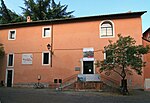San Callisto
17th-century Roman Catholic church buildings in ItalyBaroque architecture in RomeChurches of Rome (rione Trastevere)Religious buildings and structures completed in 1613Titular churches

San Callisto (English: Saint Callixtus, Latin: S. Calixti) is a Roman Catholic titular church in Rome, Italy, built over the site of Pope Callixtus I's martyrdom (c. AD 222). The original building dates from the time of Pope Gregory III (r. 731–741), who ordered the building of a church on the site. The church has been rebuilt twice since, first in the twelfth century, and the current church in 1610. In 1458 Callixtus III decreed it a titular church as a seat for Cardinals.Established in 1517, the Titulus San Calixti is currently held by Willem Jacobus Cardinal Eijk.
Excerpt from the Wikipedia article San Callisto (License: CC BY-SA 3.0, Authors, Images).San Callisto
Piazza di San Calisto, Rome Municipio Roma I
Geographical coordinates (GPS) Address External links Nearby Places Show on map
Geographical coordinates (GPS)
| Latitude | Longitude |
|---|---|
| N 41.889044444444 ° | E 12.470486111111 ° |
Address
Chiesa di San Callisto
Piazza di San Calisto
00153 Rome, Municipio Roma I
Lazio, Italy
Open on Google Maps










